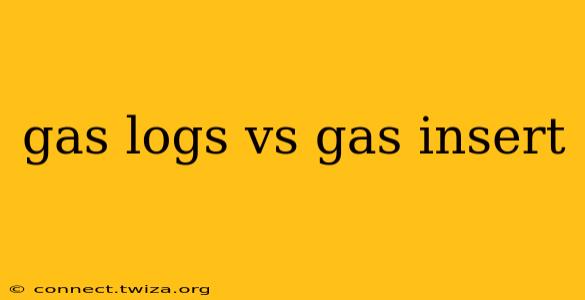Choosing between gas logs and a gas insert can feel overwhelming. Both offer the ambiance of a crackling fire without the mess and hassle of a traditional wood-burning fireplace, but they cater to different needs and preferences. This comprehensive guide will help you understand the key differences to make the best choice for your home.
What are Gas Logs?
Gas logs are essentially artificial logs designed to sit directly within your existing fireplace. They're fueled by natural gas or propane and create a realistic flame effect. Think of them as a simple upgrade to your existing setup, offering the look of a fire without significant structural changes.
Advantages of Gas Logs:
- Easy Installation: Generally, installation is straightforward and often DIY-friendly, although professional installation is always recommended for safety.
- Cost-Effective: Gas logs are typically a less expensive option upfront compared to a gas insert.
- Minimal Alterations: They require no major modifications to your existing fireplace.
Disadvantages of Gas Logs:
- Limited Heating Efficiency: Gas logs primarily provide supplemental heat and don't offer the same heating capacity as a gas insert. Much of the heat escapes up the chimney.
- Aesthetic Limitations: While advancements have made them look incredibly realistic, they may not perfectly replicate the look of a real wood fire, particularly in older fireplaces.
- No Ventilation Control: You don't have the same level of control over air intake and exhaust as you do with a gas insert.
What is a Gas Fireplace Insert?
A gas fireplace insert is a self-contained unit that is installed inside your existing fireplace. It replaces the firebox and offers significantly improved efficiency and control over the heat output.
Advantages of Gas Fireplace Inserts:
- Superior Heating Efficiency: Gas inserts are designed to heat your room more effectively, with much less heat loss up the chimney. They often come with blowers to circulate warm air.
- Improved Aesthetics: Many gas inserts offer a more realistic flame pattern and a cleaner, more modern look than gas logs.
- Better Control: Inserts allow you to precisely control the flame height and heat output. They often include features like thermostats and remote controls.
- Increased Safety: Many inserts have enhanced safety features like automatic shut-off mechanisms.
Disadvantages of Gas Fireplace Inserts:
- Higher Installation Costs: Installation of a gas insert is more complex and usually requires professional help, significantly increasing the upfront cost.
- More Extensive Modifications: The installation process may involve significant alterations to your existing fireplace, including modifications to the firebox and chimney.
- Higher Initial Cost: Gas inserts are a more expensive investment than gas logs.
Which is Better for Heating?
Gas inserts are significantly better for heating. They offer much greater efficiency and heat output due to their sealed combustion system, preventing heat loss up the chimney. Gas logs provide supplemental heat, but shouldn't be relied upon as your primary heating source.
What are the Different Types of Gas Logs and Inserts?
Both gas logs and inserts are available in various styles, mimicking different types of wood and offering various flame patterns. Consider the overall aesthetic of your room when making your choice.
How Much Do Gas Logs and Inserts Cost?
The cost varies widely depending on the brand, features, and size. Gas logs are generally less expensive, ranging from a few hundred to a couple of thousand dollars. Gas inserts, including installation, can cost several thousand dollars.
How Do I Choose Between Gas Logs and a Gas Insert?
Consider these factors:
- Budget: Gas logs are a more budget-friendly option upfront.
- Heating Needs: If you need significant supplemental heat, a gas insert is superior.
- Aesthetic Preferences: Evaluate the visual appeal of both options within your fireplace and home décor.
- Installation Complexity: Are you comfortable with DIY installation (gas logs are more likely to be DIY-friendly), or will you require professional help?
Ultimately, the best choice depends on your individual needs and preferences. Carefully weigh the pros and cons of each option before making a decision. Consulting with a fireplace professional can provide valuable insights and guidance tailored to your specific situation.
